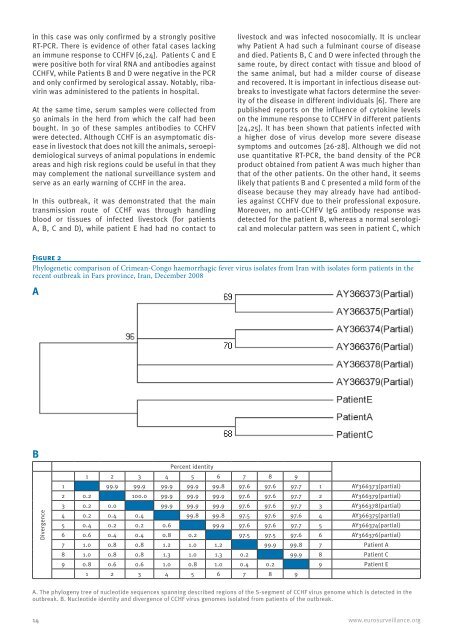Vector-borne diseases - Eurosurveillance
Vector-borne diseases - Eurosurveillance
Vector-borne diseases - Eurosurveillance
You also want an ePaper? Increase the reach of your titles
YUMPU automatically turns print PDFs into web optimized ePapers that Google loves.
in this case was only confirmed by a strongly positive<br />
RT-PCR. There is evidence of other fatal cases lacking<br />
an immune response to CCHFV [6,24]. Patients C and E<br />
were positive both for viral RNA and antibodies against<br />
CCHFV, while Patients B and D were negative in the PCR<br />
and only confirmed by serological assay. Notably, ribavirin<br />
was administered to the patients in hospital.<br />
At the same time, serum samples were collected from<br />
50 animals in the herd from which the calf had been<br />
bought. In 30 of these samples antibodies to CCHFV<br />
were detected. Although CCHF is an asymptomatic disease<br />
in livestock that does not kill the animals, seroepidemiological<br />
surveys of animal populations in endemic<br />
areas and high risk regions could be useful in that they<br />
may complement the national surveillance system and<br />
serve as an early warning of CCHF in the area.<br />
In this outbreak, it was demonstrated that the main<br />
transmission route of CCHF was through handling<br />
blood or tissues of infected livestock (for patients<br />
A, B, C and D), while patient E had had no contact to<br />
livestock and was infected nosocomially. It is unclear<br />
why Patient A had such a fulminant course of disease<br />
and died. Patients B, C and D were infected through the<br />
same route, by direct contact with tissue and blood of<br />
the same animal, but had a milder course of disease<br />
and recovered. It is important in infectious disease outbreaks<br />
to investigate what factors determine the severity<br />
of the disease in different individuals [6]. There are<br />
published reports on the influence of cytokine levels<br />
on the immune response to CCHFV in different patients<br />
[24,25]. It has been shown that patients infected with<br />
a higher dose of virus develop more severe disease<br />
symptoms and outcomes [26-28]. Although we did not<br />
use quantitative RT-PCR, the band density of the PCR<br />
product obtained from patient A was much higher than<br />
that of the other patients. On the other hand, it seems<br />
likely that patients B and C presented a mild form of the<br />
disease because they may already have had antibodies<br />
against CCHFV due to their professional exposure.<br />
Moreover, no anti-CCHFV IgG antibody response was<br />
detected for the patient B, whereas a normal serological<br />
and molecular pattern was seen in patient C, which<br />
Figure 2<br />
Phylogenetic comparison of Crimean-Congo haemorrhagic fever virus isolates from Iran with isolates form patients in the<br />
recent outbreak in Fars province, Iran, December 2008<br />
A<br />
B<br />
Divergence<br />
1 2 3 4<br />
Percent identity<br />
5 6 7 8 9<br />
1 99.9 99.9 99.9 99.9 99.8 97.6 97.6 97.7 1 AY366373(partial)<br />
2 0.2 100.0 99.9 99.9 99.9 97.6 97.6 97.7 2 AY366379(partial)<br />
3 0.2 0.0 99.9 99.9 99.9 97.6 97.6 97.7 3 AY366378(partial)<br />
4 0.2 0.4 0.4 99.8 99.8 97.5 97.6 97.6 4 AY366375(partial)<br />
5 0.4 0.2 0.2 0.6 99.9 97.6 97.6 97.7 5 AY366374(partial)<br />
6 0.6 0.4 0.4 0.8 0.2 97.5 97.5 97.6 6 AY366376(partial)<br />
7 1.0 0.8 0.8 1.2 1.0 1.2 99.9 99.8 7 Patient A<br />
8 1.0 0.8 0.8 1.3 1.0 1.3 0.2 99.9 8 Patient C<br />
9 0.8 0.6 0.6 1.0 0.8 1.0 0.4 0.2 9 Patient E<br />
1 2 3 4 5 6 7 8 9<br />
A. The phylogeny tree of nucleotide sequences spanning described regions of the S-segment of CCHF virus genome which is detected in the<br />
outbreak. B. Nucleotide identity and divergence of CCHF virus genomes isolated from patients of the outbreak.<br />
14 www.eurosurveillance.org

















